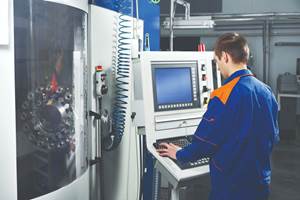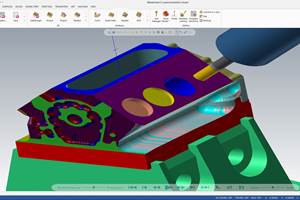CAM Helps Medical Component Manufacturer Turn Ideas into Reality
With the new version of Surfcam by Vero Software, USGI Medical manufactures precision medical devices and reduces cycle time and improves machinery usage. Watch a video interview with USGI’s Marko Caric at the bottom of this story to learn how he uses Surfcam to turn his ideas into reality.
Editor's Note: Watch a video interview with USGI’s Marko Caric at the bottom of this story to learn how he uses Surfcam to turn his ideas into reality.
It is possible to machine small, precision medical components at high speeds on entry-level machines. Just ask USGI Medical Inc. of San Clemente, California. The company is using the latest version of Surfcam CAM software by Vero Software (Thousand Oaks, California) to machine components with tolerances of 0.0005 inch on its Haas VF-1. By using the CAM system, the company says it has improved its cycle times and saved money on capital expenditures.
USGI has developed a set of instruments used for incisionless surgery on the abdominal wall. Once attached to tubing required for insertion and manipulation, the diminutive stainless steel instrument assemblies are inserted into the patient’s mouth, down the esophagus and inside the stomach. The surgical application is designed to be less invasive than other practices, says Chris Earley, senior director of engineering. The completed four-piece assembly, which measures 1.5 by 0.20 by 0.20 inch, resembles an alligator, with sharp, tiny teeth on the top and bottom jaws. It also includes a manifold and a swivel.
(The U.S. Food and Drug Administration is reviewing the safety and efficacy of USGI’s medical devices prior to commercial use in the United States. In the meantime, the system is being used primarily in Europe, where regulatory approval via a CE mark has been obtained, and in the Middle East.)
To engineer these instruments, Mr. Earley creates solid models using Solidworks CAD software by Dassault Systèmes and then hands those designs off to Marko Caric, senior R&D machinist. Mr. Caric then produces the medical assembly’s precision components, in addition to quickly machining prototypes. He also is tasked with discovering, testing and implementing new methods for continuously improving cycle times and product quality.
To program the precision parts, Mr. Caric opens the SolidWorks file in Surfcam, which USGI has used since its inception. The company says it has reaped significant production gains throughout its use of the software, beginning with the Surfcam Traditional solution. However, in 2015, USGI switched to an all-new version of Surfcam, which includes new cutting-edge capabilities that are helping the company take those gains even further.
“One of the main attractions of the new Surfcam is that I am able to load CAD files natively without translating them,” Mr. Caric says. “There is no translation required, which allows me to generate much smaller code and higher-quality tool paths. It allows me to generate NC code that goes into GO2s and GO3s on curves and splines instead of innumerable lines of XYZ code.”
Because the new Surfcam is CAD-neutral, it is designed to deliver error-free interoperability with any of the major CAD systems. Without the need for data translation, error is eliminated; the solid model and associated tool path remain identical to the original design; and concise and accurate code is generated, the company says.
The recent implementation of the latest version of Surfcam has delivered even greater flexibility, efficiency and machine control than previous versions of the software, Mr. Caric says. This is important because some of the components the company machines have a 0.005-inch tolerance on three different datums. Being able to efficiently and coherently manipulate tool paths is vital to making good parts, he says. Since the implementation, the company has improved cycle time and is now making greater use of its machinery, he adds.
For instance, although USGI’s facility houses three mills, a Haas VF-1 VMC carries the lion’s share of the workload. Utilizing drills as small as 0.016 inch and end mills as large as 0.1875 inch, Mr. Caric is able to operate the Haas at feed rates higher than in the past because of the control he has gained over his machinery. “Having this kind of control allows us to machine these parts at rates of speed comparable to machines costing two to three times as much,” he says.
Surfcam has helped USGI to save money on capital expenditures by allowing it to optimize existing equipment, and ensuring that manufacturing remains in house. With the latest version, the company has seen an approximate 20 to 30 percent reduction in cycle time, in addition to a steep decrease in deburring activity as a result of increased part quality. For example, Mr. Caric says more efficient tool paths have enabled the company to reduce its cycle times from close to 2 hours down to 10.5 minutes. “We used to spend up to 30 minutes deburring these parts by hand, and now we spend just two or three minutes. Less handling is more time savings, and we have a better quality part.”
Mr. Caric also takes advantage of the macros functionality within Surfcam to further maximize programming time. Because the software records and stores data from previous jobs, it helps him save and reuse information and best practices. He is able to easily add custom macros to automate consistently repeated processes.
“Macros save me a lot of trouble and redundancy in entering information that has already been performed on this job or prior jobs,” he says. “Every time I do a process revision, I find ways to make it much more efficient. We have the process dialed in to the point now where we take a solid bar of stock, put it inside the collet and push the button, and the finished product comes off the machine almost ready to go to assembly.”
Surfcam has helped USGI turn its ideas into reality with greater efficiency, and with enough flexibility for Mr. Caric to machine high-quality components exactly the way he wants to. “The other software packages I used just had a more generic feel to them,” he says. “They did not give me the level of control I was after nor the options I wanted. They were not as gentle on my tools as this software is.”
For Mr. Caric and the whole USGI team, the goal of delivering quality translates into the best possible results for those who will benefit most from the company’s product. “Knowing what the end product accomplishes is very satisfying,” he says. “It’s improving people’s lives.”
Related Content
Can ChatGPT Create Usable G-Code Programs?
Since its debut in late 2022, ChatGPT has been used in many situations, from writing stories to writing code, including G-code. But is it useful to shops? We asked a CAM expert for his thoughts.
Read MoreUnderstanding CNC Machine Accuracy and Repeatability
Properly evaluating machine tool capability requires understanding how the both user and the builder can influence precision.
Read More6 Machine Shop Essentials to Stay Competitive
If you want to streamline production and be competitive in the industry, you will need far more than a standard three-axis CNC mill or two-axis CNC lathe and a few measuring tools.
Read MoreCAD/CAM System Requirements: An Overview
CAD/CAM programs are among the most demanding kinds of computer software. Smooth operation requires careful consideration of computer specifications.
Read MoreRead Next
3 Mistakes That Cause CNC Programs to Fail
Despite enhancements to manufacturing technology, there are still issues today that can cause programs to fail. These failures can cause lost time, scrapped parts, damaged machines and even injured operators.
Read MoreThe Cut Scene: The Finer Details of Large-Format Machining
Small details and features can have an outsized impact on large parts, such as Barbco’s collapsible utility drill head.
Read More















.png;maxWidth=300;quality=90)














